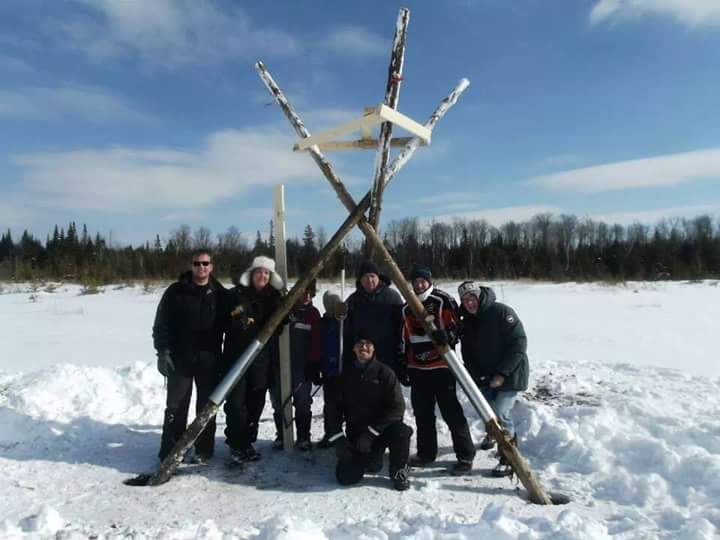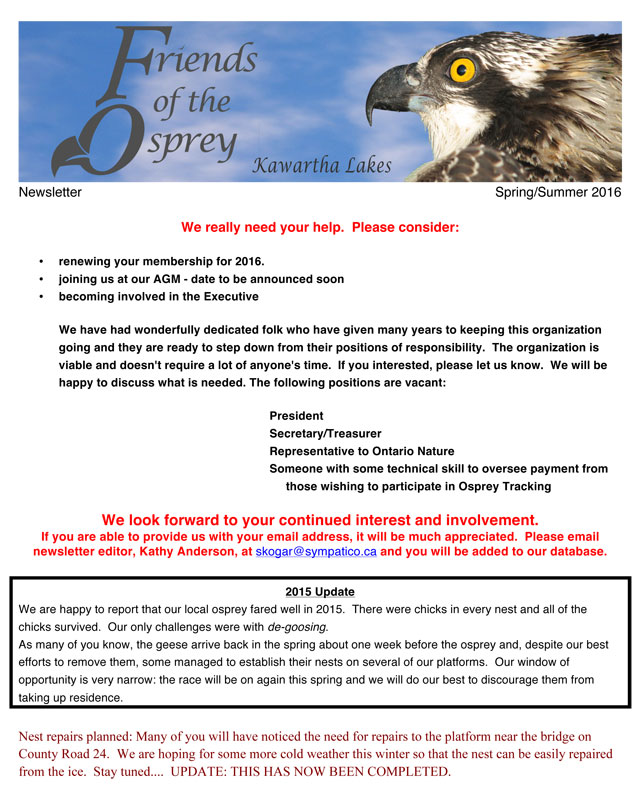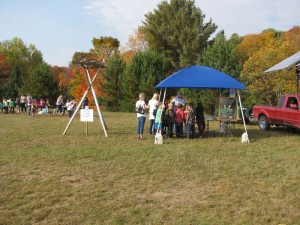Posts in Category: Blog
Proposal
This winter will be the 22nd anniversary of the erection of our first osprey platform at Alpine RV Park, Lindsay. In the intervening years we have erected 35 platforms at Buckhorn, Lakefield, Peterborough, Omemee, Lake Scugog, Kirkfield and many between Bobcaygeon and Lindsay.
We have seen many members and executives come and go. We have worked with and trained over 100 Fleming College students in our work programs. We have given osprey ecological presentations to thousands of students in their schools and at water festivals.
Our highlight may have been our osprey telemetry tracking program. It took us 5 years to raise the $15,000 necessary, but we tracked our migrating osprey to Central Brazil, 8,000 km away.
Maybe now our work is done. We have no projects in sight. The osprey are doing fine without us but we sincerely want to believe we were helpful in their recovery in our area.
As most of our Executive is between 75 and 82 years old we think it is time to quit. Thus we are proposing to rescind our charitable organization status within the next 6 months and continue as an association with no obligations to government oversight. This will mean that we will turn over our cash assets to a like-minded ecological organization.
It takes a lot of effort to set up a functioning organization such as the Friends of the Osprey and it is a shame to let it go. It is our intention to have volunteers continue to maintain existing platforms and respond to opportunities to continue educational work. We hope to get some active new members involved and proceed with the enthusiasm we had when we were younger.
If you are interested in being a part of a re-purposing plan, please get in touch with us through our Contact page.
2017 Submissions from the Community
From Debbie Seaton on August 14
I have been monitoring the nest on Golfcourse Road, Janetville. In the spring the male seemed to be sitting on a pole across the road from the nest a lot. I joked that they were having a spat, a really long spat, but alas they figured it out and the result was one baby. From my vantage point, baby is growing and the parents are both doting, as well it should be.
From Terry on August 14
Prince Edward County, specifically Waupoos, Milford, South Bay, and Cherry Valley has had an amazing Osprey season. The nest closest to me in Waupoos had 3 chicks…. most of the nests I’ve seen have been 2 chicks. No catastrophes this season thankfully, all chicks fledged. Interestingly, I’m on the East Coast at the moment, nests are empty. I have seen many Osprey though.
From Jim Chappel on August 21:
I did my usual nest check on a section of Emily Creek and the mouth into Sturgeon Lake again for the twenty-first year. Hard to believe it has been that long. Still a pretty section of the creek.
There have always been a few nests of terns but this year there were more tern chicks flying than I can remember…wish I had kept a record of them as well. There were eight tern chicks just between the first and second bend north of Hwy. 36.
Osprey nests were quite successful as well in year 2017. Of the usual six nest sites in the last several years, there were five active. One of these blew down some time in June: the nest in the large tree at Emily creek and County Road 24. A few limbs of the nest remained in the tree for some time but finally all fell. The adult osprey were seen a few times a the tree after the nest fell but soon returned no more for the rest of the season.
Of the four nests that were successful this year there were six chicks that flew, making this year one of the higher average seasons for osprey reproduction here.
All in all a good year despite the unusually wet season. Apparently osprey chicks do not mind rain and the water was high all year for good fishing. Looking forward to next season.
From Diana Wood on August 23:
The nest at Hwy 35 and Rainbow Rd. did not have any fledgling. The nest at Glenarm and Hwy 35 had a pair early in spring and we think one of the pair died. A new pair arrived and they did have one fledgling. The nest at Hwy 35 and Rosedale did have a fledgling. The nest at Hwy 35 and Coboconk did not. The nest at the airport had a fledgling. A nest was build at Hwy 35 and Bear Rd.; just south of County Rd. 8. Hydro took it down once but the pair have rebuilt it again.
2017 Nest Report
Another season is passing. The author convinced himself that last year 2016, although it was a banner year for activity for monitoring the osprey nest, almost all nests were occupied and each was telling a different story with each visit. For 2017 I would have to double up my individual visits to gain a better picture of happenings. As spring turned to summer my itinerary was proving fruitful as there were many surprises and successes along with a few disappointments and failures.
Let’s start with the latter which involves the bald eagle. The nest in question is located at Scotch Line Rd. and Rd. 24 north side overlooking Sturgeon Lake. In April the eagles evicted the osprey and took over the nest which is 5-6 storeys high in a tree. It is strange how word gets around. Shortly after, there appeared a gathering of photographers with their 3-4 foot long cameras. They would stay for hours focusing on the female sitting on an egg or eggs while the male perched as lookout on the branch above. This went on for about 2 weeks until mother nature intervened with one of her horrific storms which half destroyed the nest and assumably damaged the egg. We have information from our Simon Connell that the eagles would not attempt to repair or try nesting again until the following season biologically speaking. Upon returning a few days later I observed the nest to be completely repaired and the Lords of the sky had returned. A pair of osprey communicating with each other with that beautiful sound were back! They remained active for the rest of the summer. I never saw the eagles or photographers again. It is assumed that they were not interested in our osprey. Too bad – their loss.
This is another disappointing tree nest story. Located on Road 24 overlooking Sturgeon Lake across from the park this nest has been active for over 10 years. Again another storm blew half of the nest and eggs or chicks to the ground. It was sad to see one of the osprey sitting a few feet away just staring at the damage. A few days later the rest of the nest fell to the ground. I have not seen the osprey since and that was June.
Another disappointment takes us to Cameron-Southview Estates where Mrs. Bird has a beautiful home overlooking a narrow lagoon and an osprey nest which was deteriorating badly above the water. Simon Connell and crew decided to build an above ground platform a short distant from the old nest. It truly is a work of art. Spring came but no sign of the osprey. Upon investigating the area, the author found 100 metres away a pair of very active osprey building a nest atop a hydro pole. They remained active the rest of the summer.
Another success story takes us to Kenstone Rd. which runs north and south from Hwy. 36 to Road 24 in, of all places, a farmer’s field atop a hydro pole. The good hydro people replaced the nest and old hydro pole with a new taller pole for safety reasons. The osprey returned and remained active the rest of the summer even with 4 wild turkeys feeding at the foot of the pole.
On the surprise side we go to Hwy 26 Emily Creek bridge just south of Bobcageon. The nest is on the water and has to be degoosed in the off season because the geese arrive 2-3 weeks before the osprey and will take over the nest. We destroy the nest leaving only the platform. This pair of osprey year after year seem to be the first to arrive and amazingly built a complete nest in less than 5 days. The female must have laid 2 eggs because 2 chicks were hatched. I watched them grow over the summer and one day I witnessed all four in the very crowded quarters. In July all four vacated their home and as of September I never saw them again. This truly is a success story. This nest will have to be degoosed again.
Seriously, as FOTO is limited in person power, all nests are not being surveyed effectively and adequately as monitoring becomes an educated guess while some of us aren’t getting any younger.
The following sites have been viewed by Simon and myself while many others have never been investigated at all in the CKL:
- The Glen – occupied – 1 chick
- Emily Park – occupied
- Pigeon Trailer Park – occupied – 1 chick in nest
- Bobcaygeon Community Pool – no activity
- Bobcaygeon Locks – active
- Bobcaygeon New Bridge – active
- Nest in tree, south of new bridge – active
- Birch Point Marina – active
- Leaning tower, Rd 24 – 1 chick
- Rd. 24 opposite leaning tower – active – 1 adult
- Lindsay Airport – active
- Glenarm & Hwy 35, new hydro pole – active
- Fenelon Falls, baseball field – active
- Fenelon Falls, opposite medical centre – active This nest wasdestroyed by storm in 2016
- Elm Tree & Fishack Rd – active
- Rosedale Bridge Hwy 35 – active
- Coboconk & Hwy 35 south – active
- Coboconk, baseball field – active
While watching an episode of Animal World Sept. 4th, 2017 the bald eagle was featured in B.C. It was referred to as “Emperor of the Sky”. Included in their diet are the young heron. Our Lord of the sky, the osprey, may battle the heron, but they do not devour them. I’ve witnessed this myself.
In conclusion it is my belief that overall 2017 was a productive and encouraging year for our feathered friends. Until spring of 2018 you are invited to be the wind beneath our wings.
Happy Flying!
PS: When is the last time you saw and how many? Bugs on your windshield, swallows, frogs, turtles, bees monarch butterfly.
Ed Lawson
Director Nest Monitoring
Platform Repairs
We had a pretty successful weekend on Feb 17, 18, 2017. We built a great platform on the bog, on the island at South View Estates. The platform sits right on the bog which is largely cattails but also supporting shrubs. so it might be semi stable. We used a tripod of the new environmentally approved 4 by 4- 16 feet long. At the base these are webbed with 2×4 1 foot above the bog. The idea being that they will sink into the bog but only down to our 2×4 web. Each leg is supported by a cement block. From the center we have hung 3 cement blocks on a ratchet strap, which we presume will also sink and then we can go back and adjust the ratchet to keep the pressure on and prevent wind blow down.
I wish I could say we knew what we were doing, but this is something new and we invented as we went. It looks good and substantial. I am proud of it but we will see what happens after the thaw. This platform was built partially as a monument to the husband of our long term member Jean Bird. We moved the memorial plaque to the new platform. We met with Jean, her daughter Maggie came out to the island with us and was very pleased. By total coincidence last Saturday was the 18th anniversary of the death of Mr. Bird.
Unfortunately our other re-build project won’t get done due to lack of ice. but I think the osprey will still use the semi collapsed platform.
2016 Osprey Nesting news
We are having a very good 2016 Osprey nesting season, partly by good management and partly by good luck.
.

In midwinter we had problems due to no ice. One nest at the County Rd 24 bridge was falling down and the other needed de-goosing. The hydro pole platform at Birch Point had fallen down and we had forgotten to de-goose Ken Reid Park platform. Then we got cold weather and were able to rebuild our Rd 24 platform at the bridge the first week of March
Although the geese did visit our platforms they left again and the Osprey have re-inhabited them. At one of the platforms a bald eagle was very interested in the nest but the Osprey persuaded it find another home.
On April 20, Hydro One replaced the Birch Point Marina hydro pole platform and the Osprey are back on it.
The Hwy 36 site was de-goosed and occupied March 28.
As of April 21 all of our sites in the County Rd 24 and Bobcaygeon area are occupied by a mated pair of Osprey.
We will get up river by boat soon and see what is happening between Snug Harbour and Lindsay.
Simon
Water the Rhubarb Festival

Enjoy a delicious lakeside brunch at the Rhubarb Restaurant & support local water education through the HMK Children’s Water Festival.
Live music, silent auction and great company!
When : April 24 from 12pm – 3pm!
Cost : $20/adult & $10/child (12 and under) Cash & Cheque Payments Appreciated! Reservations Suggested, call (705)489-4449
Menu : Scrumptious buffet featuring Red Fife Pancakes from Abbey Gardens
March Newsletter is available

Here is our March newsletter. You can download it and read it here.
As it mentions in our newsletter, we really do need your help. If you can renew your membership or join, visit us at our AGM or become involved with the club, it would all be appreciated.
Our dedicated members over the years have given hundreds of hours volunteering but they are getting older and ready to hand the reigns over to new blood. It doesn’t take a lot of time to be on the Executive and it would be great if you could join us.
We are looking for a:
- President
- Secretary/Treasurer
- Representative to Ontario Nature
- Someone with some technical skill to oversee payment from those wishing to participate in Osprey Tracking.
Contact us if you wish to offer any time at all.
Haliburton, Muskoka, Kawartha Lakes Children’s Water Festival

Since the creation of the Friends of the Osprey, a major focus of the organization has been the involvement of youth education specifically
pertaining to Osprey. The importance of teaching youth about environmental stewardship and promoting understanding of nature is essential.
Presentations, farmers markets, festivals and workshops provide a way of bringing this education to elementary, high school and postsecondary
students. This year will be the third consecutive year which Friends of the Osprey has been involved with the Haliburton, Muskoka, and Kawartha Lakes Children’s Water Festival. This is a large event which allows upwards of 1200 youth in grades three to six to learn about the connected nature of wildlife, waterways and the ways humans can influence this balance.
Camp Kinark – Carnarvon September 28 ‐ 29, 2015
Cancelled until Next year
Each year the Friends of the Osprey participates in the Haliburton, Muskoka, Kawartha Lakes Children’s Water Festival. We erect an impressive display and are one of the most popular exhibits. The local school boards bus in over 1000 elementary school children to learn of the importance of protecting our waters, from wetlands to rivers and lakes to drinking water. This year’s event is Monday, Sept. 28 and Tuesday, Sept 29 at Kinark Outdoor Centre west of Carnarvon.
We need some people to help with our presentation. Groups of 6 to 12 students rush in, all talking and asking questions at the same time. We need about 3 people to keep order, do our presentation and answer questions. If you enjoy children please consider helping. You don’t need to be an expert, the questions are always the same and you will be given the prepared script. The hours are 9:00 am to 2:30 pm. It is outdoors but we have a sun and rain shelter. It is always a fun time.
Bird Tracking
Bird Tracking – report by Rob Millar
Of great importance to the survival of many species is when and where they travel throughout the year and throughout their lifetime. If a species disappears altogether from an area (extirpated), the knowledge of many things such as migration routes and food sources is lost. This is what has happened to the Trumpeter Swans which have been re-introduced into Ontario. It is hoped that they can find new routes and methods of survival to keep them alive in Ontario, Canada as they did when they were last here in the 1800’s. Fortunately for the Osprey, they have had a return to hopefully sustainable populations before this knowledge was lost to our Ontario birds. It is important to monitor migration of these birds so that their wellbeing can be tracked and maintained throughout their travels.
Friends Of The Osprey, Kawartha Lakes had tracking satellite transmitters installed onto 2 female Osprey in 2010 with the assistance of Bird Studies Canada. Although the signal was lost from one bird as it got to the Florida area, the other continued and we obtained valuable information about it’s migration to Brazil, South America each winter for a couple of years before it’s signal was also lost. The cost of this project was very high (satellite based system) and we are currently exploring the latest methods of bird tracking in the hopes that we might attempt to do it again. There are many methods and many companies supplying equipment for tracking. Here are some examples of newer methods and technologies (non-satellite systems).
eBird
Although not able to track individual birds, this new method is supplying an incredible amount of information for all species and it is important that as many people as possible are helping with this. Observations by individuals from around the world are reporting sightings and building a database that shows migration routes of all species throughout the year. With the advent of smartphones and all our internet devices, this is quickly becoming the biggest contributor to our knowledge of migratory routes and how mankind and weather affects them. Please do take time to learn about eBird and report what you see. Go to http://ebird.org/content/canada/ and create an account.
GeoTagging
This relatively inexpensive method uses a small device known as a Geolocator. It is attached to the bird and each day stores the timing and amount of light. The device is later retrieved and the data analyzed giving a complete record of where and when it has traveled. This device works best with birds that return to the same nesting sites such as Osprey. Due to its low cost, this method allows many devices to be installed and even if not all are retrieved, can be very economical. One drawback to Geo Tagging is that the information is not transmitted live for constant monitoring. Due to the small size of these devices, many small birds have been tracked with this method and previously unknown migration routes discovered.
Motus
This is a quickly developing system that is being expanded so far throughout Ontario, Quebec, and New England areas. This is the description from the website http://motus-wts.org/?lang=EN
The Motus Wildlife Tracking System (Motus) comprises a network of coordinated automated radio telemetry towers that track the movements of small organisms throughout terrestrial environments. The purpose of Motus is to facilitate landscape-scale research and education on the ecology and conservation of migratory animals. It is a program of Bird Studies Canada (BSC) in partnership with Acadia University, Western University, the University of Guelph and all collaborating researchers and organizations.
As of early 2015, the array is comprised of over 200 automated VHF radio receiving stations, positioned from Hudson Bay, along the James Bay Coast, stretching from south-western Ontario to the mouth of the St. Lawrence River, through the Maritime provinces and down the eastern seaboard to Virginia (click here to see a map of current receiver locations). A digital “nano-tag” tracking device is secured to an animal they can be detected in real-time up to 25 km away from any station. When combined, this array can track animals across a diversity of landscapes covering thousands of kilometres.
The data, which will comprise millions of individual records, are stored locally, and (optionally) transmitted back to a centralized data management system at BSC’s National Data Centre where data is filtered, archived, visualized, and disseminated. Researchers, decisions makers, non-government organizations, and the public can then query those data and examine the movements and behaviours of any species being tracked. This state-of-the-art system is the first of its kind in the world and will be open to all researchers and organizations.
GSM
Global System for Mobile communications… a fancy way for saying… cell phone text messaging. This method uses transmitters that send signals to existing cell phone towers. Although the devices (which include GPS for location) are still very expensive, the company Northstar has been charging a fraction of the cost of the devices in order to test this new technology (Cellular GPS GSM). The data will be saved and received when the bird gets close enough to a cell tower so may not be continuous. At full cost this method still costs thousands of dollars per bird per year, not much less than the satellite technology we used previously, however may be a good way to go if the price is reduced enough.
With the help of our supporters and fundraising, Friends Of The Osprey, Kawartha Lakes hopes to be able to track more Osprey if at all possible using one of the above methods.
